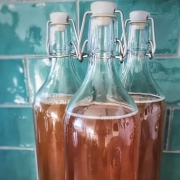Kombucha: Trend or New Staple?
September 2017. By Prof. Bob Hutkins, Khem Shahani Professor of Food Science, University of Nebraska, Department of Food Science and Technology, Lincoln.
This blog post is adapted from a piece published by the Lincoln Journal Star. The article, first published May 4, 2016 and written by Prof. Bob Hutkins, appeared as a response to a reader’s question: “I keep hearing about kombucha… What is this stuff?”
Kombucha (pronounced kom-BOO-chuh) is made by fermenting sweetened tea using a combination of yeasts and bacteria. This mixture of live cultures that starts the fermentation is called SCOBY, short for “symbiotic colony of bacteria and yeast.” The SCOBY takes the form of a gooey mat that can be re-used for each batch or shared with friends.
Kombucha is one of many trendy fermented foods, like kimchi and kefir, that are now found everywhere. No longer just the fare of hipster cafes and posh restaurants, you can find kombucha at your local grocery store—or even at Walmart.
Kombucha’s origins go back at least 2,000 years, to China; the drink gradually spread throughout Asia and Europe. In the U.S., kits for home-brewing kombucha became available to consumers in the early 1990s, and bottled versions soon appeared on grocery store shelves.
Several factors may explain the popularity of kombucha. First, many people like the flavor: uniquely sweet and sour, with a vinegary overtone. Some ethanol (alcohol) may also be present, although commercial products must contain less than the legal limit of 0.5 percent. The fermentation reaction yields carbon dioxide, which gives kombucha a pleasant fizziness. Flavor combinations are endless, from ginger, mango, and blood orange to lavender and cinnamon.
It’s probably the suggested health properties that are most responsible for the kombucha craze. The live cultures in some blends have antimicrobial activity, which may have been valuable in past eras when antibiotics were not available. However, these properties depend on the particular mix of microbes, which varies from batch to batch or brand to brand. Other suggested health benefits range from improved gut health and digestion to treatment of cancer and other diseases. Unfortunately, there is no scientific evidence to support these health claims.
It may be that kombucha is not for everyone—the acidic nature of the drink may not sit well for some people. Microbiologists have also expressed concern that home-brewed kombucha could possibly contain toxin-producing fungi. (See related post on making safe fermented foods at home.)
Nonetheless, there’s no doubt that many consumers are drinking kombucha. Annual sales in the U.S. are over $500 million, with double-digit growth. Around half of the coveted 25-to-34 age group (i.e. millennials) are kombucha drinkers. Yes, it’s popular now, but it also seems that kombucha is likely to be around for a while.
Bob Hutkins is the Food Doc. He is a professor at the University of Nebraska-Lincoln, where he teaches and conducts research in food science and food microbiology. Questions on any topic related to food, food safety, food ingredients and food processing can be sent to the Food Doc at features@nulljournalstar.com.





